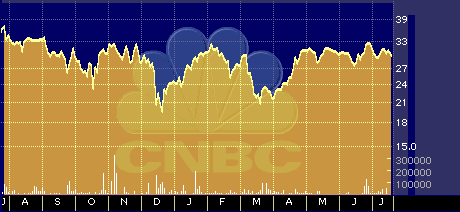
The Mouse Business Is Roaring
The Mouse Business Is Roaring
by Hal Plotkin
Silicon Valley Correspondent
Jul 29 1999 9:27AM ET
Strong sales of sub-$1000 PCs and Apple’s popular iMac computer are helping drive after-market computer mouse sales to record levels.
According to a recent report by Intellect ASW, a New York marketing group, recent numbers show a 41 percent jump in after-market mouse unit sales from May 1998 to May 1999. More than 3.2 million after-market mice — bought separate from those included with a new computer system — were sold during that period, representing slightly over $60 million dollars.
The biggest beneficiaries of the surge in mouse sales are Logitech, Inc. {LOGIY} based in Fremont, Calif., Microsoft {MSFT}, and San Mateo, Calif.-based Kensington Technology Group, Inc.
Kensington is an operating company held by the much-larger Fortune Brands {FO}, which also owns a number of other brands including Jim Beam, Titleist, Master Lock, and Day-Timer, among others.
At present, Microsoft has 22.8 percent of the mouse market, Logitech 21.3 percent, and Kensington 6.6 percent. The rest of the mouse market is controlled by more than a dozen other manufacturers, based primarily in Asia, who mostly sell into the low-margin original equipment manufacturer (OEM) market rather than through retail channels.
From an investor’s standpoint, though, Logitech looks like the biggest winner.
Unlike Microsoft and Fortune Brands, whose strong sales in other areas dwarfs the impact of their growing mouse businesses, roughly half of all Logitech revenues come from mice and newer mouse-like trackballs.
Logitech’s sales for the quarter ending June 30, 1999 increased 63 percent, topping $114.4 million, as compared with $70.1 million for the same period last year. The company’s net income likewise grew, by 15 percent, compared with the first quarter of last year, hitting $588,000.

LOGIY 52-week price chart
LOGITECH INTL S A (NNM:LOGIY)
| Analyst pinions | Average Recommendation | Earnings Per Share | |||
| Strong Buy | 0 | This Week | 3.0 | Last Quarter | N/A |
| Buy | 0 | Surprise | 0.00 | ||
| Hold | 1 | Percent | 0.00% | ||
| Sell | 0 | Consensus EPS | |||
| Strong Sell | 0 | This Year’s | N/A | ||
| Next Year’s | N/A | ||||
LOGITECH INTL S A – LOGIY ranks 30 out of 99. It is in the Computer/components industry.
Analyst Ratings compiled by Zacks
Although Logitech’s sales numbers got a boost from the company’s August 1998 $25 million dollar cash acquisition of Connectix Corp’s QuickCam digital camera business unit, the underlying strength of the company is based on the burgeoning demand for computer mice touched off by sub-$1000 PCs, new higher-margin mouse products and, more recently, Apple’s iMac, which comes equipped with a stylish mouse that many users say is an ergonomic nightmare.
Sub-$1000 PCs have accounted for as much as 65 percent of all PC sales in recent months according to PC Data, a market research firm based in Reston, Virginia.
“Most of those computers come with very basic one or two button mice,” explains Pat McBride, an analyst at Intellect ASW. “Since the cost of those PCs is so low, buyers have a little extra left in their pockets which they’re willing to spend on a new mouse,” he says.
Martin Reynolds, an analyst at the GartnerGroup who tracks the mouse business, says “adding a new mouse to your computer is one of the highest value things you can do to customize your PC.”
Newer mice or trackball products now on the market improve the functionality of computers and enhance user productivity, says Reynolds.
“Using the little wheel that some of the newer mice have to scroll through documents adds another dimension to the experience of using your PC,” he says. It also adds another dimension to the profit picture for mouse makers. “We get about a $10 premium for that,” says Julie Goebel, Logitech’s senior product manager for mice.
Apple’s popular new iMac computer is also contributing to the boom in mouse sales. The iMac comes equipped with a round, translucent mouse that many users find troublesome. Within a few weeks of the iMac’s debut, computer retailers were already selling little plastic sleeves that fit over the iMac’s round mouse to give it the shape and feel of a more traditional mouse.
While there is no hard data yet on how many iMac users are buying new mice, Reynolds thinks dissatisfaction with the iMac’s mouse could lead as many as one million iMac users to buy replacement mice this year.
That development is another advantage for Logitech, which not only makes iMac-compatible replacement trackballs that plug into the iMac’s Universal Serial Bus (USB) port ,but also manufactures, under contract, the original mice that come with the iMac.
“It was their design,” says Logitech’s Julie Goebel. “Apple has done us a little favor,” she adds, noting that demand for Logitech’s more versatile USB-compatible iMac replacement mice and trackballs is running particularly strong.
Trackballs are similar to mice but contain no moving parts that come in contact with the surface on which they are placed, making them more reliable and less prone to getting gummed up. Trackball products are also molded in the shape of the human hand to reduce ergonomic tensions.
Overall sales of trackballs are outpacing even the fast-growing mouse business. Unit sales of trackball’s were up 89 percent last year, with revenues up 54 percent, reaching $28 million dollars for the industry as a whole, according to Intellect ASW.
Given recent trends, betting on the overall growth of the PC business makes sense to many investors, despite declining PC profit margins and the surplus of PC vendors that makes picking the right PC-maker a challenge.
But, no matter which low-price PC vendor wins the battle, one thing seems certain: there are going to be a whole lot of new mice running around the desktop.


